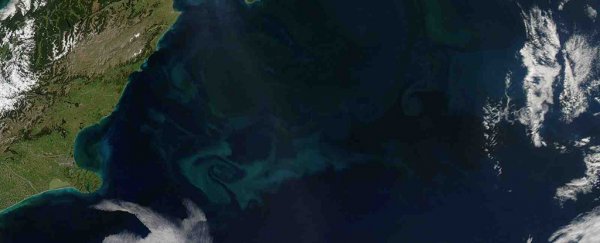Scientists have spotted milky white plankton blooms off the coast of New Zealand, and say it's the latest ecological evidence that our oceans are getting warmer due to human-caused global warming.
The blooms are the remnants of the white algae coccolithophore, and while they're the result of a natural shedding process, new research shows that these blooms are moving further south as cooler seas react to a rise in temperature.
Researchers from the Victoria University of Wellington in New Zealand used satellites and ship observations to chart the algae blooms, which match up with a previous period of natural ocean warming some 130,000 years ago.
When coccolithophore die, they leave behind what's called coccoliths – an outer layer made from plates of calcicum carbonate. Once shed, these turn the seas white before slowly sinking to the ocean floor.
"Our results show that during that last warm period, when the ocean was about 1 to 2 degrees warmer than present, sediments on the seabed were mainly made up of coccoliths," says lead researcher Bella Duncan.
These coccoliths create a kind of white mud on the ocean floor, which means scientists can spot their effects from as far away as space. They can also be found in chalk, and are part of the White Cliffs of Dover in the UK – another natural phenomenon caused by a warm period in our planet's history.
"The same process appears to be happening now, suggesting the New Zealand ocean is currently responding [to] the present phase of global warming," says one of the team, Lionel Carter. "This is also a trend that has been increasingly observed in other parts of the world."
The research follows an international study published earlier in the year that found the world's oceans have effectively been 'shielding' us from the devastating effects of global warming since at least the 1970s – but it looks like that protective power is finally starting to buckle.
As ScienceAlert's Josh Hrala explained for us at the time:
"The findings suggest that our oceans have 'absorbed' 93 percent of the warming effects of climate change, causing them to become sicker and sicker in the process. This could explain why temperature changes haven't been felt as broadly on land."
Migrations by sea creatures – such as the plankton in the latest study – are part of the consequence of this, as is the growth of harmful bacteria in waters around the world.
To compare today's blooming events to coccolith deposits from the past, the researchers behind the new study analysed sediment cores extracted from the Campbell Plateau to the south of New Zealand.
"In a 2-metre core you have a 200,000-year-old record of sediment deposition," says Duncan. "We took samples at frequent, regularly-spaced intervals down the cores to gain an insight into coccolith production in the past."
The sediments showed that abundances of coccoliths match up with warmer periods in Earth's history, although the scientists say they don't know what the impacts will be on oceans in the short term.
"While the ramifications of this change on fish stocks, uptake of carbon dioxide, and general ocean health have yet to be evaluated, it is clear that change is underway," says one of the researchers, Lionel Carter.
Coccoliths have long been used by scientists to map the changing currents and temperatures of the world's oceans, although the water can sometimes look green or turquoise rather than white when viewed from above.
The phytoplankton marine plants that create them have an important role to play beneath the waves, not just marking changes in ecosystems but also contributing to them, such as extracting carbon dioxide from the atmosphere for photosynthesis.
Let's hope these new observations can be used to spot trends, so we can address some of the consequences of warmer seas.
With the ocean surface temperature now hotter than it's been for more than a century, and rising all the time, every little bit of analysis helps.
The findings have been published in Global and Planetary Change.
Image: The coccolith blooms shown above appear as swirls of green when viewed from above. Credit: Jeff Schmaltz, MODIS Land Rapid Response Team, NASA GSFC
